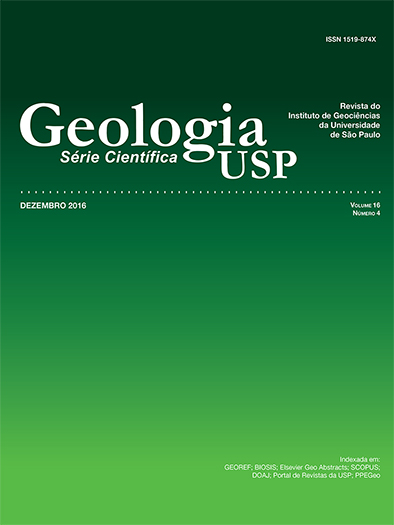Pennsylvanian conifers from interglacial taphoflora of Monte Mor, Itararé Group, State of São Paulo, Brazil: the earliest of the Paraná Basin
DOI:
https://doi.org/10.11606/issn.2316-9095.v16i4p7-22Keywords:
Early conifers, Paranocladus-Ginkgophyllum-Brasilodendron Association, Paraná Basin.Abstract
The pre-glossopterid macroflora from the Volpe Ranch, in Monte Mor (State of São Paulo), was deposited during an interglacial context of the Itararé Group. It is characterized by the Paranocladus-Ginkgophyllum-Brasilodendron Association and is included in the middle-basal part of the Itararé Group outcrop, in the NE of the Paraná Basin. It is similar to the Argentine macrofloristic association Krauselcladus-Asterotheca Phytozone (ex-Interval Zone) and its palynofloristic contents belong to the Crucisaccites monoletus Palynozone (Kasimovian to Gzhelian). The conifers in this assemblage are represented by macro and microfossils and record the first level of occurrence of conifers in the basin. They are documented by leafy branches impressions and compressions of Paranocladus dusenii Florin and Buriadia heterophylla (Feistmantel) Seward and Sahni emend. Singh, and platyspermic seeds of the genus Paranospermum. Cuticular studies allowed to correlate the presence of Paranocladus dusenii with the platyspermic seeds Paranospermum cambuiense Ricardi-Branco and to identify a new species of Paranospermum as well. Previous palynological studies in this level led to the recognition of some pollen grains affinis to the gymnosperms (conifers, ginkgoaleans and pteridospermales) comprising monosaccate and bisaccate forms allocated to the genera Cannanoropollis, Plicatipollenites, Potonieisporites and Caheniasaccites indicating certain diversity of conifers as early as in Pennsylvanian. The association of conifers and Ginkgophyllum represents a mesoxerophytic tree community. The abundance of their fragmented material in the taphofloral assemblage suggests allochthonous origin transported toward a deltaic plain which were associated to a parautochthonous origin material. Their fossiliferous sandy matrix overlying the coal also suggests a higher energy agent of transport.
Downloads
Published
Issue
Section
License
Authors who publish in this journal shall comply with the following terms:
- Authors keep their copyright and grant to Geologia USP: Série Científica the right of first publication, with the paper under the Creative Commons BY-NC-SA license (summary of the license: https://creativecommons.org/licenses/by-nc-sa/4.0 | full text of the license: https://creativecommons.org/licenses/by-nc-sa/4.0/legalcode) that allows the non-commercial sharing of the paper and granting the proper copyrights of the first publication in this journal.
- Authors are authorized to take additional contracts separately, for non-exclusive distribution of the version of the paper published in this journal (publish in institutional repository or as a book chapter), granting the proper copyrights of first publication in this journal.
- Authors are allowed and encouraged to publish and distribute their paper online (in institutional repositories or their personal page) at any point before or during the editorial process, since this can generate productive changes as well as increase the impact and citation of the published paper (See The effect of Open Access and downloads on citation impact).





